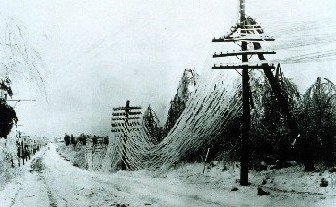|
Ice Storms - Winter's Worst Weather Disasters
Ice storms, although not the most spectacular form of severe weather, can result in personal injury and death, plus huge repair bills. The conditions leading to ice storms are not particularly unusual. What is out of the ordinary is the persistence of usually short lived periods of freezing rain to the point where the thickness of the ice severely disrupts transport and its weight causes tree branches to break and power lines and their supports to fail.

Ice storm, Chicago, January 1967
It's definition time. Only a few, but an explanation of just what goes on before and during ice storms should be helpful.
During cold weather, precipitation can take a number of forms
Freezing rain forms when a layer of relatively warm moist air is sandwiched between layers of air below the freezing point. This commonly happens in winter in advance of a warm front, which overrides a mass of colder air but itself cools to well below freezing at altitude. For example, these conditions often occur when moist air from the Gulf of Mexico moves northward and encounters a high pressure zone of drier colder polar air.
Snow forms in the upper high layer, and if the middle layer is thick enough it will melt on the way down. If the bottom cold layer is very thin, rain will fall.
A little thicker, and the rain drops become supercooled. When they land, they come into contact with surfaces already below freezing point, spread out, and instantly freeze to a film of ice. Normally roads and sidewalks become icy, icicles form, and icy sculptures develop on leaves and branches, but usually these events are short lived.
If the bottom cold layer is thicker, the raindrops are there long enough to form sleet. And of course, if the middle warm layer is thin or wedged out, snow will persist all the way to the ground. For a little more detail, here is an excellent Frozen Rain page.
Normally the freezing rain is restricted to a narrow zone and will move on and be replaced by rain or sleet.
The real problems start when the warm front becomes blocked by a stationary cold air mass. The normal passage of different types of precipitation becomes stalled, and freezing rain persists for days, developing into a full scale ice storm. When this occurs, supercooled rain continues to freeze on the ground and on nearby objects, and the thickness and weight of ice disrupt power and transport.
Ice formation on roads is faster than efforts to clear it, airport runways are similarly affected, and even if they can be kept clear, ice forming on planes has to be removed before they can take off.
Ice forming on branches can add so much weight that the branches break, becoming threats to passers by, powerlines, cars and houses. At the same time, powerlines can become so heavy that poles snap, and even pylons can fail. Disruption to power can become widespread, and restoration may take days or weeks. This creates its own dangers to households who lose heating, light and cooking facilities.
This is essentially what happened in Canada and nearby parts of New York State in 1998, and resulted in a Canadian damage bill of $3 billion. An excellent account of the Canadian Ice Storm can be found in these pages. But it's not only the broader scale disruptions that are important.
Freezing rain and ice storms are responsible for much human tragedy, particularly from vehicle accidents on slippery roads. The seemingly ordinary instances of slipping on steps, paths and while trying to negotiate roads also take their toll. Such simple accidents, which may be humorous if no one gets hurt, can lead to broken bones, paraplegia, or death.
So while freezing rain can result in an instant winter wonderland of icicles and decorated trees and shrubs, it does have its darker side. And if freezing rain persists, the resultant ice storm can result in one of winter's greatest disasters.
For more information, visit the Severe Weather page and its links. Back to the Top, or return to the Home page. You may be interested to know that you can find out more about weather and home weather stations by receiving our newsletter ,"Watching Weather". It's published more or less weekly, and apart from tips on how to use your weather station and understand what it's telling you about the weather around you, it also covers many other weather related topics. If this sounds interesting, just add your name and email address to the form below. When you join, you'll also receive, totally free, a 20 page guide to setting up and trouble shooting problems in home weather stations. And I promise that you won't get spammed, and that your sign up details will remain totally confidential. Sign up now and receive your first issue almost immediately.
Last update 05/25/2011
|




